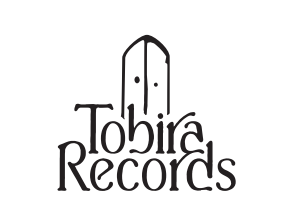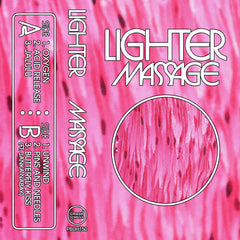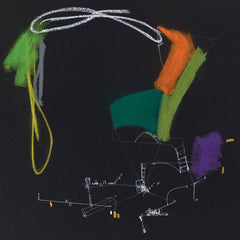SMET Studio Di Musica Elettronica Di Torino // Musica Elettronica / Computer Music 1966-1972 LP
- Availability:
イタリアの実験音楽家Enore Zaffiri率いるSMET Studio Di Musica Elettronica Di Torinoが、2024年5月に同国実験レーベルDie Schachtelからリリースした再発レコードです。(オリジナルは1971年リリース)
未発表音源3曲含む計9曲を収録。
以下、レーベルによる解説です。
"SMET - Studio di Musica Elettronicaは1964年、Enore Zaffiriのアイデアからトリノで誕生した。当初、スタジオは初歩的な機材を使用し、会議やオーディションを通じてこの前衛的な音楽分野の知識を広めると同時に、独自のサウンド体験を開発することを目的としていた。新しい機器へのアプローチは、構造主義的アプローチによる厳格な研究手法に従ったもので、「スタジオ・ディ・インフォルマツィオーネ・エステティカ」(美的情報スタジオ)を中心とした視覚的オペレーターとの密接な関係があった。1966年、音楽実験に興味を持つ若い音楽家や大学生のために、実験的な電子音楽コースが開設された。
1968年、イタリア教育省は、トリノの "G.ヴェルディ "音楽院に電子音楽の実験的コースを設立することを承認した。1970/71年、シンセサイザーの登場とともに、方法論的、思想的に急激な変化が起こった。シンセサイザーは、電子音楽と過去の音楽芸術との理想的な架け橋となる楽器となった。エレン・カッペルの協力のもと、電子的に処理されない声が、最も古い楽器と最も現代的な楽器の融合を促進した。その活動は、コンサート、ミュージカル劇場、バレエ、映画、ビデオテープなど、さまざまな分野で展開された。
この(今では超レアな)レコードが出版された年は、イタリアにおけるエレクトロニックミュージックの進化のターニングポイントだった。1972年、アルマンド・ジェンティルッチによる『電子音楽入門』が、有名な出版社フェルトリネッリから出版されたのである。この時期、ピエトロ・グロッシ、エノーレ・ザフィリ、テレサ・ランパッツィは、最も重要な作曲経験を積む機会を得た。彼らは、作品の交換、互いのコラボレーション、巡回展への参加、旅行、執筆、放送の企画など、さまざまな活動に従事し、このレコード盤のリリースは、イタリアにおける電子音楽の進化の転機となった。
ZaffiriとSMETが共有したイデオロギーは、『Musica Elettronica / Computer Music 1966-1972』に明確に集約されている。音と形式を緻密にコントロールする電子音楽は、伝統的な作曲法や楽器の熟練という制約から解放される唯一の方法である。それは、探究心と共同作業によってのみ達成できる実験的な試みである。1972年に発表された『Musica Elettronica / Computer Music』は、象徴的なEMS VCS3シンセサイザーの紛れもないサウンドと、IBM 360コンピューターで生成された音色をフィーチャーしたもので、フォニット・セトラ・スタジオで数枚だけプライベートプレスされた。この見事な作品は、やがて当時のイタリアン・アヴァンギャルド・エレクトロニックLPの中で最も希少で人気の高い作品のひとつとなった。"
レーベルその他作品はこちら /// Click here to see more Die Schachtel releases available at Tobira.
---------------------------------------
12" black vinyl. Edition of 210. Comes in deluxe cover with handmade silver foil printed on 450g paper. Includes 3 bonus tracks and a 30x30cm double-sided insert with detailed notes and a SMET / Enore Zaffiri exhaustive chronology.
Tracklist:
1. EL.25 02:48
2. C12 01:10
3. SP/Z 14 a.b 03:00
4. Immigrati 06:27
5. Fawn 07:54
6. Ex Tempore Cantus 03:47
7. Living Synthi n.7 05:33
8. Wake in Progress 10:22
9. Ordinali Ordinati 04:57
Text by Die Schachtel:
" The SMET - Studio di Musica Elettronica was born in Turin in 1964, from an idea by Enore Zaffiri. In the beginning the Studio worked with rudimentary equipment, aiming to disseminate knowledge of this avant-garde musical sector through conferences and auditions and, at the same time , developing its own sound experiences. The approach to the new equipment followed a rigorous research method with a structuralist approach, in close relationship with visual operators orbiting around the “Studio di Informazione Estetica” (Aesthetic Information Studio). In 1966 an experimental Electronic Music course was opened for young musicians and university students interested in musical experimentation.
In 1968 the Italian Ministry of Education approved the establishment of an experimental course in Electronic Music at the “G. Verdi” Conservatory in Turin. In 1970/71, with the advent of the synthesizer, a radical methodological and ideological change occurred. After rigorous structuralism, the live concert was introduced: the synthesizer became the instrument with which to build an ideal bridge between electronic music and the musical art of the past. With the collaboration of Ellen Kappel, the voice, not treated electronically, favoured the union between the oldest instrument and the most modern one. The activity developed in various sectors: concerts, musical theatre, ballet, films, video tapes.
The year of this (nowadays super rare) vinyl's publication was a turning point in the evolution of electronic music in Italy. 1972 saw the publication of “Introduction to Electronic Music” by Armando Gentilucci, the first volume written by an Italian, in Italian, to examine technological advancements, by the renowned publishing house Feltrinelli. During this period, Pietro Grossi, Enore Zaffiri, and Teresa Rampazzi had the opportunity to develop their most significant compositional experiences. They engaged in a variety of activities, and this vinyl release marked a turning point in the evolution of electronic music in Italy, such as exchanging works, collaborating with each other, participating in itinerant exhibitions, traveling, writing, and organizing broadcasts.
Zaffiri and SMET's shared ideology is clearly summed up on “Musica Elettronica / Computer Music 1966-1972”: electronic music, with its meticulous control over sound and form, is the only way to break free from the constraints of traditional compositional methods and instrumental mastery. It is an experimental endeavor that can only be achieved through a spirit of exploration and collaboration. Originally issued in 1972, and featuring the unmistakeable sound of the iconic EMS VCS3 synthesizer along with tones generated on a IBM 360 computer, “Musica Elettronica / Computer Music” was privately pressed in a handful of copies at the Fonit Cetra studios. This stunning artefact soon turned into one of the most rare and sought after Italian avant-garde electronic LPs of its era."
Artist : SMET Studio Di Musica Elettronica Di Torino
Label : Die Schachtel
CAT No : DS45
イタリアの実験音楽家Enore Zaffiri率いるSMET Studio Di Musica Elettronica Di Torinoが、2024年5月に同国実験レーベルDie Schachtelからリリースした再発レコードです。(オリジナルは1971年リリース)
未発表音源3曲含む計9曲を収録。
以下、レーベルによる解説です。
"SMET - Studio di Musica Elettronicaは1964年、Enore Zaffiriのアイデアからトリノで誕生した。当初、スタジオは初歩的な機材を使用し、会議やオーディションを通じてこの前衛的な音楽分野の知識を広めると同時に、独自のサウンド体験を開発することを目的としていた。新しい機器へのアプローチは、構造主義的アプローチによる厳格な研究手法に従ったもので、「スタジオ・ディ・インフォルマツィオーネ・エステティカ」(美的情報スタジオ)を中心とした視覚的オペレーターとの密接な関係があった。1966年、音楽実験に興味を持つ若い音楽家や大学生のために、実験的な電子音楽コースが開設された。
1968年、イタリア教育省は、トリノの "G.ヴェルディ "音楽院に電子音楽の実験的コースを設立することを承認した。1970/71年、シンセサイザーの登場とともに、方法論的、思想的に急激な変化が起こった。シンセサイザーは、電子音楽と過去の音楽芸術との理想的な架け橋となる楽器となった。エレン・カッペルの協力のもと、電子的に処理されない声が、最も古い楽器と最も現代的な楽器の融合を促進した。その活動は、コンサート、ミュージカル劇場、バレエ、映画、ビデオテープなど、さまざまな分野で展開された。
この(今では超レアな)レコードが出版された年は、イタリアにおけるエレクトロニックミュージックの進化のターニングポイントだった。1972年、アルマンド・ジェンティルッチによる『電子音楽入門』が、有名な出版社フェルトリネッリから出版されたのである。この時期、ピエトロ・グロッシ、エノーレ・ザフィリ、テレサ・ランパッツィは、最も重要な作曲経験を積む機会を得た。彼らは、作品の交換、互いのコラボレーション、巡回展への参加、旅行、執筆、放送の企画など、さまざまな活動に従事し、このレコード盤のリリースは、イタリアにおける電子音楽の進化の転機となった。
ZaffiriとSMETが共有したイデオロギーは、『Musica Elettronica / Computer Music 1966-1972』に明確に集約されている。音と形式を緻密にコントロールする電子音楽は、伝統的な作曲法や楽器の熟練という制約から解放される唯一の方法である。それは、探究心と共同作業によってのみ達成できる実験的な試みである。1972年に発表された『Musica Elettronica / Computer Music』は、象徴的なEMS VCS3シンセサイザーの紛れもないサウンドと、IBM 360コンピューターで生成された音色をフィーチャーしたもので、フォニット・セトラ・スタジオで数枚だけプライベートプレスされた。この見事な作品は、やがて当時のイタリアン・アヴァンギャルド・エレクトロニックLPの中で最も希少で人気の高い作品のひとつとなった。"
レーベルその他作品はこちら /// Click here to see more Die Schachtel releases available at Tobira.
---------------------------------------
12" black vinyl. Edition of 210. Comes in deluxe cover with handmade silver foil printed on 450g paper. Includes 3 bonus tracks and a 30x30cm double-sided insert with detailed notes and a SMET / Enore Zaffiri exhaustive chronology.
Tracklist:
1. EL.25 02:48
2. C12 01:10
3. SP/Z 14 a.b 03:00
4. Immigrati 06:27
5. Fawn 07:54
6. Ex Tempore Cantus 03:47
7. Living Synthi n.7 05:33
8. Wake in Progress 10:22
9. Ordinali Ordinati 04:57
Text by Die Schachtel:
" The SMET - Studio di Musica Elettronica was born in Turin in 1964, from an idea by Enore Zaffiri. In the beginning the Studio worked with rudimentary equipment, aiming to disseminate knowledge of this avant-garde musical sector through conferences and auditions and, at the same time , developing its own sound experiences. The approach to the new equipment followed a rigorous research method with a structuralist approach, in close relationship with visual operators orbiting around the “Studio di Informazione Estetica” (Aesthetic Information Studio). In 1966 an experimental Electronic Music course was opened for young musicians and university students interested in musical experimentation.
In 1968 the Italian Ministry of Education approved the establishment of an experimental course in Electronic Music at the “G. Verdi” Conservatory in Turin. In 1970/71, with the advent of the synthesizer, a radical methodological and ideological change occurred. After rigorous structuralism, the live concert was introduced: the synthesizer became the instrument with which to build an ideal bridge between electronic music and the musical art of the past. With the collaboration of Ellen Kappel, the voice, not treated electronically, favoured the union between the oldest instrument and the most modern one. The activity developed in various sectors: concerts, musical theatre, ballet, films, video tapes.
The year of this (nowadays super rare) vinyl's publication was a turning point in the evolution of electronic music in Italy. 1972 saw the publication of “Introduction to Electronic Music” by Armando Gentilucci, the first volume written by an Italian, in Italian, to examine technological advancements, by the renowned publishing house Feltrinelli. During this period, Pietro Grossi, Enore Zaffiri, and Teresa Rampazzi had the opportunity to develop their most significant compositional experiences. They engaged in a variety of activities, and this vinyl release marked a turning point in the evolution of electronic music in Italy, such as exchanging works, collaborating with each other, participating in itinerant exhibitions, traveling, writing, and organizing broadcasts.
Zaffiri and SMET's shared ideology is clearly summed up on “Musica Elettronica / Computer Music 1966-1972”: electronic music, with its meticulous control over sound and form, is the only way to break free from the constraints of traditional compositional methods and instrumental mastery. It is an experimental endeavor that can only be achieved through a spirit of exploration and collaboration. Originally issued in 1972, and featuring the unmistakeable sound of the iconic EMS VCS3 synthesizer along with tones generated on a IBM 360 computer, “Musica Elettronica / Computer Music” was privately pressed in a handful of copies at the Fonit Cetra studios. This stunning artefact soon turned into one of the most rare and sought after Italian avant-garde electronic LPs of its era."
Artist : SMET Studio Di Musica Elettronica Di Torino
Label : Die Schachtel
CAT No : DS45




![Matthewdavid // Uncleared LP[COLOR] / TAPE](http://tobirarecords.com/cdn/shop/files/un1_06e5ad17-fff5-42ce-9fa3-a2d630274808_medium.jpg?v=1722407485)


![FINAL EXIT // Born in hell LP [BLACK/COLOR]](http://tobirarecords.com/cdn/shop/files/born_28f27235-3386-457d-9c1c-3bc43dd179c8_medium.webp?v=1728607359)